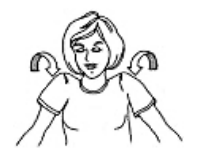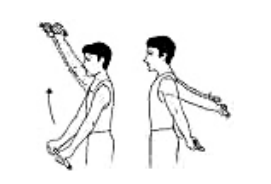Following injury, your shoulder may be swollen, bruised and painful due to sprained muscles, tendons and ligaments. It is important to carry out regular exercises to regain movement of the shoulder joint and prevent any stiffness developing. However, do not overuse the shoulder as it may aggravate your pain.
During the first three days
- It is important to rest your arm to prevent further swelling. You may have been provided with a sling (or collar and cuff ) to support the arm. If so, use it.
- Frozen peas or crushed ice in a damp tea towel can be applied to the painful area. For maximum effect, apply for up to 15 minutes, every 2 hours. Cold can burn, so remove if uncomfortable.
- Once the worst of the pain begins to settle, it is important to start gently moving the injured arm. This may well be uncomfortable at first, but is essential to avoid future stiffness. Check that you can move your elbow, wrist and hand fully. Use your other arm to assist the movements of your injured shoulder. Move into discomfort, but short of pain.
Repeat 4 – 5 times daily: Move your shoulder forwards and out to the side.

After three days
You can now gradually discard your sling and progress your exercises to the following:
Try these simple exercises:
- Shrug your shoulder 20 times.
- Circle your shoulders backwards 20 times.
- Circle your shoulders forwards 20 times.
- Bring your shoulders forwards towards each other 20 times.
- Brace your shoulders back 20 times.

To start the next set of exercises, place one of your feet forwards as if you were about to stride forwards. You can stand next to a table and support yourself with your good arm if you need to. You should let your injured arm hang down by your side. Keep your elbow straight. Let your injured arm swing like a pendulum:
Allow your injured arm to hang loosely away from your body.
- Slowly swing your arm backwards and forwards alongside your body. Start with small movements and then gradually move as far as possible in each direction. Repeat x 20.
- Now swing across your body and out to the side as far as possible. Repeat x20.
- Move the arm in a circular motion. Start with small circles increasing to larger circles. Clockwise x 20, anti-clockwise x 20.
You should do these next exercises gently at first, and then gradually increase the movement.

Fold your arms loosely and lift them over your head. Your good arm can help to lift your injured arm.
- As above, but use a stick held between your out-stretched arms.
- Stand and face a wall. Keep your elbows straight and lift your arms sideways above your head.
- Hold a stick and put your arms behind your back and lift backwards.
- Put your hands behind your head and brace your elbows outwards.

We recommend taking regular simple painkillers. Arrange to see your GP if there is no improvement or your condition deteriorates. Physiotherapy can be arranged by your GP.
Please contact your GP or NHS111 for any queries or concerns.